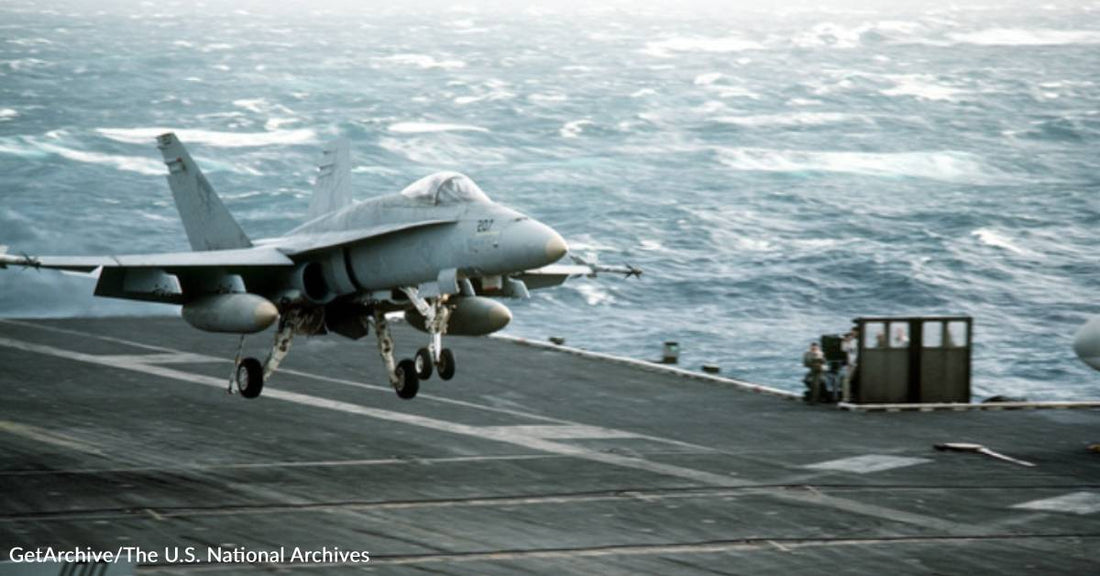Practice Makes Perfect For Navy Carrier Pilots
Dan Doyle
One of my “bucket list” dreams, a dream that will sadly never be fulfilled, is to experience taking off and landing on an aircraft carrier. The concept has fascinated me since childhood. It is one thing to take off from a modern aircraft carrier, to be flung, as it were, like a stone out of a slingshot, engines firing full blast, leaving the solidity of the carrier deck into the ethereal lightness of sky where an aircraft settles into the environment it was made for...but to land again on that deck...ah, there’s another thing altogether.
We have all probably seen videos taken from the cockpit of a Navy or Marine Corps fighter jet approaching, setting up for landing, and coming in for a landing on what appears to be a moving postage stamp in the middle of the vast ocean. This is where the real flying skills of our Navy and Marine Corps pilots come to play. This element of flying a carrier-based Marine Air Wing F/A-18 Hornet is chock-full of potential disaster, but it is, and has always been, the absolutely essential skill to master in line with the very meaning and purpose of a U.S. Navy aircraft carrier.
Jimmy Doolittle’s Army Air Corps B-25s, which undertook the raid over Tokyo a mere four months after the Japanese attack on Pearl Harbor, only had to take off from the rising and falling deck of the USS Hornet in April of 1942. As improbable and risky an adventure as that was, those pilots didn’t have to learn how to land on that deck again, for, among other reasons, it would not have been possible...at all!
But for today’s U.S. Navy and Marine Corps pilots, the carriers that they are attached to are their homes when they are on deployment missions. They are launched out on their missions from those carrier decks and they return to them for fuel, rearmament, and maintenance. It is their home base. The real skill, then, is to be able to bring those multi-million dollar, highly advanced and sophisticated fighter jets home, to land them efficiently on the deck of that aircraft carrier that is pitching and rolling on the open sea.
To master the complex intricacies of landing a modern F/A-18 Hornet or an EA Growler on one of these modern Nimitz-class or Ford-class carriers takes lots of practice. In line with this, the Marine pilots of Carrier Wing 5 will be flying to the island of Iwo Jima from the Marine Air Station at Iwakuni, Japan, this week to practice the art of carrier landings in preparation for the upcoming summer deployment of the USS Ronald Reagan (CVN-76). The USS Ronald Reagan has been homeported at Yokosuka, Japan, the homeport of the U.S. Navy’s 7th Fleet, since December 16, 2022. She is the centerpiece of Carrier Strike Group 5, to which Marine Carrier Wing 5 is attached.
Pilots from Carrier Wing 5 will undergo 10 days of training on the Island of Iwo Jima. They will fly at least 6 sorties, practicing touch-and-go landings during that time. Three of those sorties will be done during the day and three at night. Junior pilots will do more extensive training and may complete as many as 12 or more touch-and-goes per sortie.
There is a landing strip at Iwo To on Iwo Jima that approximates the length and width of a carrier deck that has been used for Carrier Wing 5 practices since 1991. But this site presents its own problems, and the Japanese Defense Ministry has plans for developing a new site for these practice needs on Mageshima Island, south of Kyushu, the southernmost of the 4 main islands that make up Japan. The project will cost $1.6 billion. Naval Forces Japan promises that it will minimize the noise while “balancing our obligation to maintain operational readiness.” Other sites that have been used in the past have brought complaints from local residents concerning the noise.
I live near Whidbey Island in Washington State. Naval Air Station Whidbey Island is home to aircraft carrier-based EA Growlers, and there is a small airstrip for practicing touch-and-go carrier landings in the middle of the island, near Coupeville. There, too, some locals complain about the occasional noise that is part and parcel of these practices. These planes take off and land at NAS Whidbey Island at the north end of the island all the time and, yes, they are noisy. There is a sign at the entrance gate to the air station that expresses a simple idea. It reads: "Excuse our noise, it is the sound of freedom."
As I said at the outset, I would love to experience all of the elements of taking off and landing on an aircraft carrier in one of those EA Growlers out of NAS Whidbey Island, but it isn’t going to happen. But we can all take comfort and be glad that the United States Navy and the United States Marine Corps have pilots that excel in these skills and in all the other skills that are necessary to be flying some of the most sophisticated combat aircraft in the world. “Bravo Zulu!” and “OooRah!”





